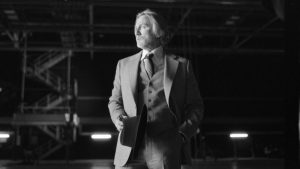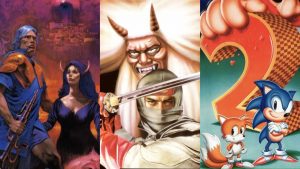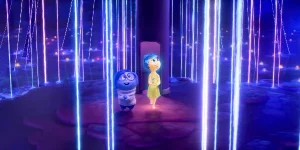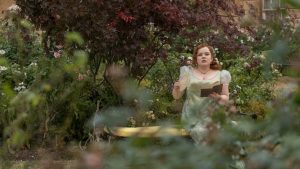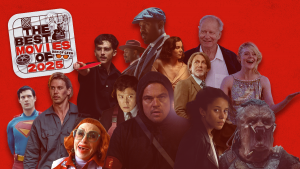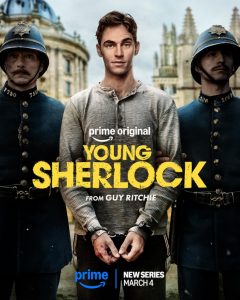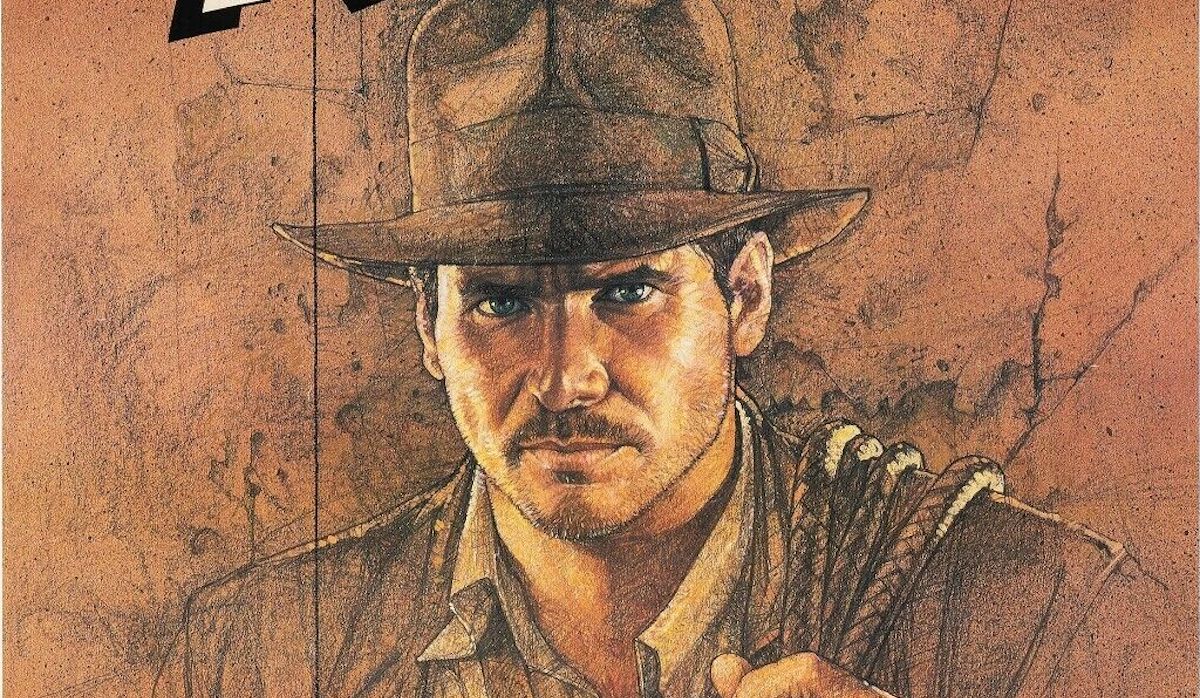
Steven Spielberg and George Lucas’ summer in Hawaii circa 1977 might just be among the most fortuitous vacays in movie history. One of the Hollywood young gun directors was dejected during this holiday because he’d just been passed over to helm the next James Bond picture; the other was anxious about his new film opening that weekend—a little flick you might have heard of called Star Wars. Neither was entirely certain what he’d do next, but the pair got to talking about an idea Lucas had been kicking around for years. It would be inspired by all the B-serials they grew up watching; it would be way cooler than 007; and it starred a guy named Smith, Indiana Smith.
The concept was almost there, clearly, yet it would take both filmmakers, plus a legion of collaborators, to turn Indiana Jones into the cinema legend he is today. And a legend he is, with Lucas’ fortune-seeker given such monumental life by Harrison Ford that more than 40 years after Raiders of the Ark came out, studios were still spending north of a quarter-billion dollars to follow Dr. Jones’ exploits as a septuagenarian.
The star of five films released across 42 years, Indiana Jones has left a mark on generations of moviegoers and anyone who’s ever found themselves humming a few bars of John Williams while wearing a fedora. Each Indy film has its admirers—yes, even Crystal Skull—and all have left an impression on everyone who’s seen them. But what is the best Indiana Jones adventure, and which fell into the quicksands of time or bad taste? We offer our humble rankings below.
5. Indiana Jones and the Kingdom of the Crystal Skull (2008)
There are few better examples of astronomical hype for a sequel giving way to crushing disappointment. Nearly 20 years after Indiana Jones rode off into the sunset in a film titled “The Last Crusade,” the coolest man to ever wear a tweed jacket was back, as were Spielberg, Lucas, and the perpetually wonderful Karen Allen as Marion Ravenwood. However, they brought with them Soviets, buckets of CGI, and a tone too goofy by half, even for a series which previously featured Indy surviving falling out of a plane by riding an inflatable raft down the side of a mountain. Oh, and the aliens Lucas was obsessed with shoehorning into the mythos certainly didn’t help.
Yes, Indiana Jones and the Kingdom of the Crystal Skull really is the weakest movie in the series. Still, we cannot bring ourselves to hate it with the rabid intensity the internet tells us we should. For starters, Harrison Ford was jazzed to be back in the leather jacket after visibly growing bored with many of his 2000s star vehicles. This Indy is older and grumpier (a bit like the actor), but there is a gleefulness in how he swings those fists, or sets up stuntmen to swing on those whips. His smile is infectious, too, when he gets to remind audiences this guy is a nerd. Additionally, even a bored and disengaged Spielberg can still stage the hell out of a set piece. The motorcycle chase through Indy’s university is as playful and light on its feet as anything the Beard has framed this century, and there’s a tangible pleasure from on 1950s nostalgia throughout.
Unfortunately, most of those best elements all occur in Crystal Skull’s first act, as does a misjudged beat where Indy survives a nuclear explosion in a refrigerator. Sure, the image of the man in the fedora meeting the atomic age is a potent one, but the movie does nothing meaningful with it. Instead we retread the Raiders formula with worse villains, a lame MacGuffin, and a truly miscast sidekick in Shia LeBeouf as Indy’s hitherto unknown son. Not even the sweet note of Indy and Marion tying the knot can salvage the movie’s muddled back half.
4. Indiana Jones and the Dial of Destiny (2023)
The 21st century Indy movies are admittedly a step or five down from the original trilogy. But unlike the previous entry on this list, we can fully go to bat for Indiana Jones and the Dial of Destiny. The film is the obvious outlier of the five, marking the only time one of these was not directed by Spielberg. It’s also the first Indy to be shot on digital, the only installment to run over two and a half hours, and the lone aberration where Ford was at the fragile age of 79 during shooting. Nonetheless, the movie achieves a gracefulness that justifies its existence and which eluded Crystal Skull.
Pivoting toward a more melancholy and elegiac tone than the previous four films, Dial of Destiny leans into Dr. Jones’ advanced years and paints a portrait of the character that is both more human and bitterer than audiences remember. Yet those bold, dramatic choices allow the third act to reach an emotional crescendo as Ford’s Indy is able to take stock of his life while also doing what he always dreamed of: coming face-to-face with our ancient past. That outrageous Rod Serling-esque climax makes up for the movie’s faults, including a serpentine pacing, too much emphasis on the uncanny valley created by CGI de-aging, and the fact director James Mangold cannot stage a set piece anywhere close to Spielberg’s magic touch. But who can?
Indiana Jones and the Dial of Destiny is an imperfect movie, and yet it gives Ford the poignant swan song he missed in the previous outing. It also looks great in the scenes where it gets away from the blue screens, improving on Janusz Kaminski’s washed cinematography in 2008. The picture likewise adds one last great sidekick to the lore courtesy of Phoebe Waller-Bridge’s Helena. It turned out to be a final ride worth taking.
3. Indiana Jones and the Temple of Doom (1984)
Of all the films on this list, Indiana Jones and the Temple of Doom has aged the worst. Sure, every Indy adventure is based on romantic and antiquated ideas from the West’s ages of exploration and colonialism, but Temple of Doom is specifically modeled on Rudyard Kipling’s Gunga Din and features an extremely problematic depiction of India that is littered with evil, human-sacrificing cults which need to be put down by a white savior and the British Army. In other words, it ain’t for everyone in the year 2024.
So with that disclaimer out of the way, we can now also acknowledge Temple of Doom is the wildest, weirdest, and most black metal detour Indy ever went on. In a franchise defined by chasing the highs of Raiders of the Lost Ark, it’s cool the first sequel went its own way and got nasty. Gone is the formula of racing Nazis (or Soviets) to a well-known MacGuffin after a proper sit at Indy’s day job in academia. Temple of Doom skips that noise! Instead we begin with a Cole Porter musical number performed in Mandarin, and with Indy in a Sean Connery-inspired tux. Then we’re asked to watch this civilized veneer get rapidly stripped away until Dr. Jones is left to rot in rags at the gates of Hell. Seriously, there’s a lake of fire here which victims are lowered in alive after having their hearts ripped out by Mola Ram (Amrish Puri)!
This is a pulpy horror story of escape and survival. Spielberg might have regretted those elements later, and helped convince the MPAA to create the PG-13 rating in the U.S. as a result, but we’re glad the Beard went this hard once in a family movie. Temple of Doom features the best set pieces in the series outside of Raiders, too. And the literal cliffhanger climax where a collapsed rope bridge dangles over a river stuffed with crocodiles is an all-timer. Also Kate Capshaw’s Willie Scott might be a misogynistic miss, but Ke Huy Quan’s Short Round is still Indiana Jones’ true son.
2. Indiana Jones and the Last Crusade (1989)
If Spielberg and Lucas gave into their grossest impulses in Temple of Doom, Indiana Jones and the Last Crusade was a chance to indulge a softer sentimentality. By introducing Indy’s reserved and distant father, Henry Jones Sr., Spielberg found a way to turn his tomb raider into a real character. And by getting Sean Connery, Spielberg’s favorite Bond, to play that father, he turned The Last Crusade into one of the best double acts in a blockbuster.
The oil and water chemistry between Ford and Connery is delicious, especially as Connery plays against type as a nebbish academic who nevertheless turns out to be something of a lady killer. Spielberg projects some of his own hang-ups onto Indy, and as a result Ford makes a meal out of the character’s new vulnerable side. Their adventure is a bit of a clone of Raiders of the Lost Ark’s plot, and few of the new action sequences live up to what they did the first time around—although the sequence where stuntman Vic Armstrong takes on a Nazi panzer on horseback is a crackling exception. What matters though is heart, and this movie has more of it than any other installment.
Additionally, this list would be incomplete if it did not mention cinematographer Douglas Slocombe’s monumental contributions to the first three Indy movies. And his colors rarely looked more gorgeous than when he channeled both John Ford and David Lean while framing the Jonses riding off into the sunset over Petra.
1. Raiders of the Lost Ark (1981)
Could this ranking end really any other way? Spielberg and Lucas captured lightning in a bottle when they had Harrison Ford gently snatch a golden idol from a temple. The filmmakers then cut it, printed it, and sold it around the world. Raiders of the Lost Ark is one of the foundational films for our modern era of big budget moviemaking, and it still moves with as much precision and finesse as Indy’s whip.
From that opening scene with the boulder on through the most masterful exposition dump in cinema, Raiders leaps out of the gate with assured confidence and effortless charm. Spielberg and Lucas were inspired by the B-serials of their youth, but they made an epic one for every subsequent generation by way of Ford’s singular blend of rugged charisma and intellectual gawkiness, and the crackerjack paces they put that creation through. The snake pit in Egypt (“why did it have to be snakes?”), the truck chase where Indy ends up being dragged through the gravel at 40 miles per hour, or just the pure, dreadful awe of the Ark of the Covenant being opened. Every sequence in Raiders sings.
As does the other crucial bearded talent responsible for the character’s longevity: John Williams. The music the composer conjures in all of the original three films is immense, but there is an otherworldly majesty to Raiders’ various themes that is as miraculous as its MacGuffin. From the beloved “Raiders March” to “Marion’s Theme,” a leitmotif so melodious it could be a lullaby, the score of Raiders elevates an already perfect adventure movie to an ethereal realm filled with joy, sorrow, and Nazi-punching. It’s one of the best movies ever made.
The post Indiana Jones Movies Ranked from Worst to Best appeared first on Den of Geek.
